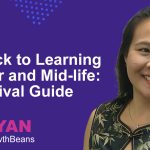It is not uncommon for us to find ourselves at a crossroads, grappling with uncertainty in our personal and professional spheres. Yet, it is crucial to remember that such moments of ambiguity are not dead ends but opportunities for growth and transformation. This is the central premise of the insightful book by Joan P. Ball, an esteemed associate professor of marketing, titled Stop, Ask, Explore: Learn to Navigate Change in Times of Uncertainty.
In the book, she presents a series of accessible practices that act as a compass, guiding readers through the transitional phases of their lives.
Embrace uncertainty with dispassionate curiosity for growth
Uncertainty is an inescapable part of life. During these moments of uncertainty, we often find ourselves at a crossroads, asking the question, “What now?” These instances, while unsettling, are not necessarily negative. Instead, they can be seen as opportunities for creation, reflection, and redefinition of our priorities.
There are three key steps when confronted with a “What now?” moment:
- Stop
- Ask
- Explore
Firstly, “Stop”. This involves pausing to acknowledge the emotions that arise in response to a perceived threat, such as the fear of losing one’s job. It is important to take a moment and allow oneself to regain composure before responding to the situation.
The second step is to “Ask”. This involves creating a “curiosity loop” by intentionally asking oneself reflective questions about the situation. For instance, one might ask, “What is the root cause of my fear?” or “What are the potential outcomes of this situation?” This process of questioning creates a space for learning. It facilitates a deeper understanding of the situation at hand.
The final step is to “Explore”. If the line of inquiry leads to a clear solution, it is time to move forward. However, if it raises bigger questions, exploring other possible actions or solutions is necessary. For example, if one is offered a new job role but is unsure about it, they might negotiate a trial period or conducting informational interviews. This allows them to gather more information before making a decision.
Effectively managing uncertainty requires a systematic approach of pausing, questioning, and exploring. The goal is to replace feelings of fear and emotional reactions with a neutral and inquisitive mindset. This method not only assists in navigating through uncertain circumstances but also transforms them into opportunities for learning and development.
Active resilience is self-awareness and taking proactive action
Resilience is a quality that is often spoken about, especially in the context of overcoming adversity. It is a trait that enables individuals to bounce back from setbacks and navigate challenging times.
Michael Ungar, a renowned resilience researcher, offers a comprehensive definition of resilience in uncertain times. He describes it as the ability of individuals to find their way to resources that support their psychological and physical well-being and negotiate for these resources in meaningful ways.
One of the key concepts in resilience-building is the development of “active resilience”. This involves a proactive assessment of one’s own resilience levels across these 10 aspects of one’s life:
- Friends and family
- Community involvement
- Environmental awareness
- Recreational activities
- Health and fitness
- Career and work
- Financial stability
- Spiritual beliefs
- Learning and growth opportunities
- Love and partnerships
To develop active resilience, it is recommended to conduct a self-assessment across these 10 areas. This involves assigning a ranking between 1, indicating the least resilience, and 10, indicating the most resilience, to each area. This ranking should reflect how one might respond or react to significant, life-altering events in these areas.
This practice of self-assessment can reveal areas of perceived vulnerability where one feels particularly threatened by change. Identifying these areas is crucial in building resilience, as it allows one to proactively recognise and address these vulnerabilities.
For instance, if one identifies a low resilience ranking in the area of career and work, they might decide to invest in professional development opportunities to enhance their skills and employability. Similarly, a low ranking in the area of health and fitness might prompt one to adopt healthier lifestyle habits.
Moreover, this self-assessment can highlight the resources one needs to mobilise to prepare for adversity. These resources could include social support, financial savings, professional networks, or personal coping strategies.
Aligning actions with personal values is important
Navigating through uncertainty requires a clear alignment of priorities with personal values, needs, and desires, followed by decisive action. This process includes four key steps:
- Learning
- Discernment
- Making a choice
- Confirmation
Learning involves reflecting on the insights gathered during the exploration and experimentation phase. It’s important to identify what sparks excitement, as well as what triggers frustration or fear. These emotional responses can provide valuable clues about the path forward.
The next step is discernment, a crucial phase that requires a shift from the divergent thinking used during exploration to the more focused, convergent thinking needed for execution. This is the time to reflect on how priorities may have shifted in light of new insights. It’s also the time to assess whether there is sufficient information to make an informed decision about the next steps in life or career.
The third step involves making a choice. This could involve a clear action plan that needs prioritising or require weighing up various options before selecting the most suitable one. This decision should consider what is most valued, needed, and desired.
The final step is confirmation. This involves creating a personal system to recognise when a choice isn’t yielding the desired results. For instance, success could be measured in outcomes, with a plan to change course if the anticipated results aren’t achieved within a specified timeframe. This step ensures a mechanism is in place to reassess and adjust the course of action if necessary.
Embrace uncertainty with courage, humility, and passion
In the face of uncertainty, it is crucial to harness the power of courage, humility, and passion to navigate the uncharted territories of life effectively. The journey of navigation helps individuals connect with what is truly important to them, allowing their actions to align with their passions.
However, learning to manage these passions is essential to ensure they do not interfere with the decision-making process. When emotions run high, following passions blindly can lead to disastrous outcomes. However, once a new life or career plan has been chosen with a clear mind, passions can be a source of intrinsic motivation and resilience.
Embrace an ethos of lifelong learning. This is not just about acquiring new knowledge or skills but also about learning to adapt to new situations and challenges. It’s about being open to new experiences and willing to step out of your comfort zone. It’s about being able to take risks, make mistakes, and then learn from them.
This article is co-created by NexPage, a translated book summary app, and Workipedia by MyCareersFuture.














